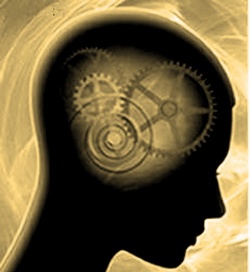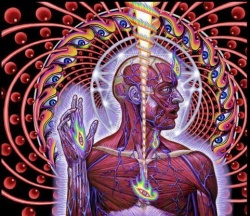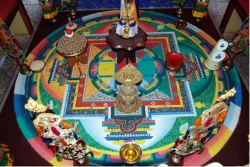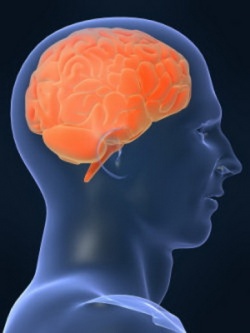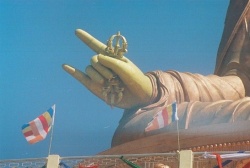Vajrayana Vipassyana
<poem>
Most people in Nepal are completely unaware of Vajrayana Vipassyana. This is a sad situation considering the fact that Nepal as a whole and Kathmandu in specific has been the land of Vajrayana since before the time Vasubandhu came to the Kathmandu valley around 400 AD. Even so called Vajracharyas have no idea that their own practice is also a form of Vipassyana, and most Pali Vipassana practitioners do not even think there are other forms of Vipassyana in the Mahayana - Vajrayana tradition. If one were to pursue even a little bit of ancient Sanskrit Shastras one will know that the Sanskrit word Vipassyana is as ancient as the Pali word Vipassana.
According to Kamalashila in his Bhawanakrama and Aniruddhacharya in Abhidhamathya Sanghaha “Vi” means special or varied (vivid), total or holistic and ”passyana“ is to see. English words like insight, holistic sight, sight of totality explain some of the meanings of Vipassyana. More accurately, to see or gain insight into Vastusthiti is Vipassyana.
The Buddha has given 4 foundations to Vipassyana - again found in both Pali and Sanskrit texts:
Vedananusmriti Dharmanusmriti Kayanusmriti Chittanusmriti
It is seeing into the Vastusthiti as it is, in all its totality of these four foundations that are classically called Vipassyana. Most of the forms of Anusmriti found in the Theravada tradition today are Vedananusmriti but the other three are also found to some extent. For example, Buddha Das teaches a form of Chittanusmriti. Likewise, most of the Vipassyana found in Vajrayana / Mahayana is Chittanusmriti though the other three are also found.
The Bhawanakrama of Kamalashila, Shantarakshita, etc. are manuals on Chittanusmriti Vipassyana. Coming to more Tantric methods, Chandali Yoga (Tummo in Tibetan) of the 6 Yogas of Naropa is a combination of Vedananusmriti and Chittanusmriti. Deva Yogas like Chakrasambhara or any deity practices are all Chittanusmriti.
Since we cannot go into details with all the infinite varieties of Vipassyana found in Vajrayana in this short essay, we will talk of just Deva Yoga in general.
Simply speaking, Deva Yoga consists of two aspects – Utpannakrama (Generation Stage), which is the Samatha aspect and Sampannakrama (Completion Stage), which is the Vipassyana aspect.
In order to practice Tantric Mahamudra (Tantric Vipassyana), it is very important to receive the full Abhisheka (initiation/empowerment) of a major Anuttara Tantra deity from a qualified Master. We have to be very clear about two important points from the above statement - 1. What or who is a qualified Master? and 2. What is Anuttara Deity?
A qualified Master in Vajrayana is called a Vajracharya. A Vajracharya is not a caste as is typically the case in Kathmandu/Nepal but a person who has received teachings and initiations from a qualified Master that belongs to a pure lineage, and has practiced according these teachings either to a very high level or has achieved full Enlightenment. A pure lineage is a very important concept in Vajrayana. It is a type of lineage that has remained unbroken since Shakyamuni and has produced Siddhas in each generation. There are many kinds of lineages like scholastic lineages of Madhyamika, Abhidharma etc., ritual lineages etc. however enlightened lineage is one which not only has all the Upadeshas, Shastras, Abhisheka vidis intact, but also has been producing Siddhas in every generation to the present day.
In order to practice Anuttara Tantra, one must receive Abhisheka from such a Vajracharya. I really do not know if there are such Vajracharyas with all the oral instructions of the total Deva-Yoga practice who is also a Siddha among the Newars or Tamangs. If there are such siddhas, the Nepalese people would be happy to know, I am sure. Among the Tibetans however, many such lineages with lineage Masters still exist. I would like to enlist the names of such Vajracharyas who are now living in Nepal so that the Nepalese public can benefit from them. The Ven. Thrangu Rinpoche, Ven. Chokyi Nyima Rinpoche are two who belong to the Kagyu lineage coming from Shakyamuni through Nagarjuna, Naropa, Marpa etc. to the present day. Ven. Thinley Norbu, Ven Chatrul Rinpoche, Chokling Rinpoche belong to the Nyingmapa lineage which entered Tibet through the Mahasiddha Padmasambhava and H.E. Chobgay Trichen Rinpoche, and Tarig Rinpoche are from the Sakya tradition coming from the great Chetriya Mahasiddha Virupa. There are many other Tibetan Vajracharyas now living in India and all over the world.
Most of the Masters residing in Kathmandu have completed their Khenpo in their studies, (which is equivalent to Ph.D.) and completed at least 3 years of strict retreat. Venerable Chatral Rinpoche did a 30 year retreat. Ven. Trangu Rinpoche is a KhenChen (Mahopadhyaya). H.E. Chogay Trichen Rinpoche was / is the abbot of Nalendra (Nalanda) of Tibet and has spent the major part of his life in retreats. It is said that if H.E. Chobgay Trichen Rinpoche were to give Abhisheka of all the deities he has attained Siddhi in, it would take 18 months to complete. They are all very humble and unless one has been in long and close contact with them, one would not know these qualifications about them. It is needless to say, but from my personal experience and those of hundreds of others, they all have well developed Avigya (riddhi-siddhi), but like true humble Buddhists, they would deny it themselves and pretend not to have them. I also know very well if they knew I was writing these things about them, they would all discourage me from doing so. I am writing this so that the Nepalese public has an opportunity to know that such Masters exist right here in Nepal. On top of these qualifications, they are poets and many are invited regularly by international institutions like Cambridge or Harvard Universities to give talks. It is unfortunate that the scholastic and research institutions of Nepal are completely oblivious of them. Personally, this is a good gauze of the poverty of the intellectual standard of Nepal.
Now we shall deal with the 2nd question regarding Anuttara Yoga. First of all, Tantra in the Buddhist context is totally different from Hindu. The entire culture is different. The meaning of the word is different - based on two different etymologies of the Sanskrit language. In Buddhism, it means continuum, which is related to Chitta-Santaan (mental continuum), whereas in Hinduism, it means liberating the finite consciousness by merging it into the Infinite. Since there is no such Infinite in Buddhism into which the finite consciousness can merge and there is not ultimately real finite consciousness, it cannot merge into an Infinite. The whole Hindu context found in Hindu Tantra does not apply at all to Buddhist Tantra. In Hinduism, Tantra has earned a bad name but this is not true of Buddhist Tantra within Buddhism. Anyway, the word Tantra does not mean the same thing in the two systems as many uninformed scholars have thought.
Within Buddhist Tantra, there are four classes of Tantra according to the New School and six classes of Tantra according to the Prachina Sampradaya (Old School). According to the New School, they are Kriya Tantra, Charya Tantra, Yoga Tantra and Anuttara Tantra. The Old School divides the Anuttara into Maha, Anu and Ati. We cannot go into explanations of all these types in this short essay but we will take up deities of the Anuttara Tantra and see how Samatha / Vipassyana is practiced. The deities used in Anuttara Tantra are Hevajra, Kalachakra, Chakrasambhara, Vajra Bhairava, Mahamaya etc. First of all, they are called Anuttara because there are none higher than these or higher practices than these. This is the only type of meditation which can give Enlightenment in one lifetime. The actual meditation of each of these deities varies in details but they all have certain common similarities. It is not possible to give their detailed practice here because of lack of space and one must also have received initiations in order to get this information.
First of all, it is very important to understand that unlike Hindu deities all Buddhist deities (not only Anuttara) do not really exist. They do not have a separate existence different from the display of the Mind itself. They have only relative existence like all phenomenon.
The purpose of the visualization of deity Mandala is not only Devanussati as mentioned in the Pali scriptures, which are related to Samatha through absorption in the qualities of the deity, but also with these elaborate Mandalas’ very deep psychological links, it is very easy to arrive at very subtle mind.
This part of the meditation is called Utpanna Krama (Generation Stage) and is the Tantric method of bringing about Samatha and also consists of repetitions of mantras. Some Theravadi Vipassana practitioners believe that there are no mantras used in Theravadi Vipassana at all. I suggest they read Jack Kornfield’s Living Buddhist Masters where he has clearly shown that many Laos Theravada Masters use mantras to bring about Samatha. The mantras used in Vajrayana are not merely devotional like Namo Buddho etc but in fact they are intimately related with Nadis and Chakras which again are related with the subtle energies of the mind. Vajrayana mantras quickly open up blocked Nadis which are making the mind unclear and this helps in easily achieving high levels of Samatha fast.
The next step is to use the Nadis and Chakras to arrive at the most subtle level of the mind called Mrityuprabhaswar (Clear Light Mind) in Vajrayana and Bhawana in Pali. This is still Samatha, but at a very high level. The first part of visualizing oneself as the deity and Mandala is related to the 1st Abhisheka whereas the Nadi-Chakra practice is related to the 2nd Abhisheka. Although Hindu Tantra also uses Nadi-Chakra, its use is totally different from Buddhism. In Vajrayana, mind is not only quickly made concept-less, it is actually made to replicate the death process and it is quickly made to arrive at its subtle level. After having developed the mind to a very subtle level in the practice of the 1st and 2nd Abhishekas, which are equivalent to Tantric Samatha, the 3rd and 4th Abhishekas are brought into practice. This part is the Vipassyana part. Here basically very advanced forms of investigating this very subtle mind are brought into play. Trek Chö, Vajra Lochani Yoga etc. are some of the advanced methods to do Chittanusmriti Vipassyana. There is a slight difference in Vajrayana Chittanusmriti and Theravada Chittanusmriti. In Theravada Chittanusmriti, only Chaitasiks are noted as such, for example, if mind is sad, sad is noted, if thoughts arise, thoughts are noted. This is an external Chittanusmriti Vipassyana because it notes and deals with only what is technically called Chaitasik. The Vajrayana Vipassyana does not note Chaitasik only, it investigates directly the Chitta itself to discover the Vastusthiti. The Chitta is the mind that notes the Chaitasik in Theravada Vipassyana. So Vajrayana Vipassyana is deeper in level. Since the root of all experiences of the world is based on our Chaitasik, and the root of Chaitasik is the Chitta and the root of Chitta is Chitta Swaroop. There can be no possibility of Bodha until one knows the nature of mind. The second part of the Vajrayana practice called Sampanna Krama is exactly the meditation on Chitta Swaroop. So Sampanna Krama is the subtlest form of Vipassyana possible.
So, by the constant practice of Utpatti Krama (including Utpanna Krama) and Sampannakrama gradually, like two sticks rubbing against each other, the fire of Sahaja Gyana arises in the practitioner. Anatma is found in all forms of Buddhism and all forms of Buddhism practice the Vipassyana to discover Anatma. But there are levels of meanings to this word Anatma. Just seeing that there is no Atma in the 5 Skandhas is gross Anatma. It is a very slow method to cut the deeper levels of Atma Graha. Sunyata of the 5 Skandhas and all phenomena is a deeper level of Anatma and such meditation cuts at a deeper level of Atma Graha and is therefore a quicker way to Enlightenment. But discovering the Chitta Swaroop or the Vastusthiti of the subtlest level of mind is the deepest level of Anatma. It cuts at the source of all other forms of Atma Graha or conception of Atma. So Vajrayana Sampanna Krama (Vipassyana) is like cutting the taproot of the tree. That is why it is the only spiritual system in the world which boasts that it can give Enlightenment in one lifetime. It is not enough to recognize the Chatta Swaroop. One must stabilize in that knowledge and Vajrayana has infinite methods to help practitioners easily stabilize in that state. That is why it is also called Upayayana.
When one is established in the Chitta Swaroop i.e. the subtlest level of Anatma, all forms of ignorance is cut at the root and that is called Sahaja Gyana, Mahamudra, Siddhi, Vajra Avastha, Vajropamasamadhi, Bodha, Apratistita Nirvana etc. in Vajrayana. Through Vajrayana, literally millions of people have achieved Mahamudra siddhi in India, Nepal, Tibet, Mongolia, China, Japan, Korea, Central Asia, Afganistan etc. from very ancient time till today. If a person has achieved Mahamudra siddhi, certain manifestations spontaneously arise at the time of his death. For example, at the time of death, the body vanishes into rainbow light or rainbows appear outside the house or in the sky where the body is kept even when there is no sign of any cloud. Also, earthquakes can be felt and storms can develop. The body can also gradually shrink to the size of a 8 to 16 year old person and the body does not decay even after many days of the person’s death. There are many other phenomena which show which level the practitioner was in, but that is a topic for another article.
